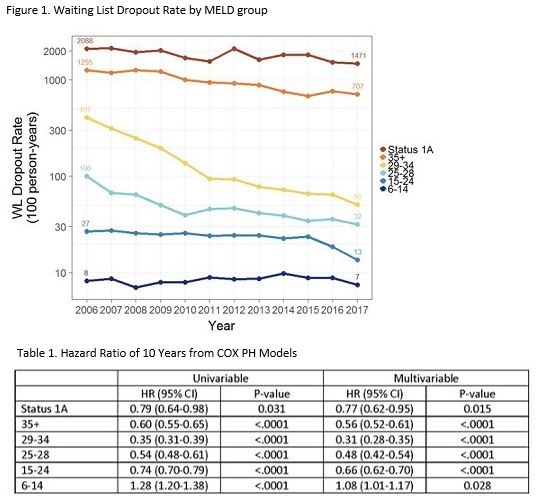Large Decrease in Liver Waiting List Dropout Rate for MELD > 14
1SRTR, Minneapolis
2Stanford University, Stanford
3Univ of Minnesota, Minneapolis.
Meeting: 2018 American Transplant Congress
Abstract number: A271
Keywords: Allocation, Liver, Liver transplantation, Public policy
Session Information
Session Name: Poster Session A: Liver: MELD, Allocation and Donor Issues (DCD/ECD)
Session Type: Poster Session
Date: Saturday, June 2, 2018
Session Time: 5:30pm-7:30pm
 Presentation Time: 5:30pm-7:30pm
Presentation Time: 5:30pm-7:30pm
Location: Hall 4EF
Median MELD at transplant has increased steadily over the past 10 years. One possible mechanism is decreased waitlist dropout rates, particularly among liver candidates with higher MELDs. We evaluated the rate and hazard of waitlist dropout by MELD group.
We selected active adult deceased donor liver candidate statuses from the SRTR standard analysis files Jan 1, 2006-Jun 30, 2017. Dropout (waitlist mortality or removal due to becoming too sick) rates were calculated by MELD group and year. Cox proportional hazard (PH) models were used to estimate the effect of time (per 10 years) by MELD group. Potential confounders (age, BMI, sex, blood type, race, Latino ethnicity, private vs. public insurance) were univariately associated with hazard of dropout. In a multivariable model without MELD group, all were significant (p<.0001) except Latino ethnicity (p=.52).
Dropout rates by MELD group decreased from 2006 to 2017, except for MELD group 6-14, which remained steady (Figure 1). The Status 1A and 35+ MELD groups had large absolute decreases (617 and 548 fewer dropouts per 100 person-years, respectively). The 29-34 and 25-28 MELD groups had large relative decreases (87.6% and 68.4%, respectively). In Cox PH models, all MELD groups, except 6-14, had significant decreases in hazard over time (Table 1), especially in MELD group 29-34, where a candidate had one-third the hazard of dropout of a similar candidate 10 years prior. All hazard ratios remained significant after adjusting for potential confounders. Results were similar in a subgroup of candidates without exception statuses.
Dropout rates decreased dramatically over the past 10 years in all candidate groups with MELD >14, especially in the MELD 29-34 group. While more analysis is required to identify causal factors, such as improved pretransplant care or changes in listing practices, lower dropout has likely contributed to increased MELD at transplant in this period.
CITATION INFORMATION: Schladt D., Pyke J., Israni A., Kim W., Lake J., Snyder J. Large Decrease in Liver Waiting List Dropout Rate for MELD > 14 Am J Transplant. 2017;17 (suppl 3).
To cite this abstract in AMA style:
Schladt D, Pyke J, Israni A, Kim W, Lake J, Snyder J. Large Decrease in Liver Waiting List Dropout Rate for MELD > 14 [abstract]. https://atcmeetingabstracts.com/abstract/large-decrease-in-liver-waiting-list-dropout-rate-for-meld-14/. Accessed December 21, 2025.« Back to 2018 American Transplant Congress

